A Comparatively Experimental Study on the Performance and Emission Characteristics of a Diesel Engine Fueled with Tung Oil-Based Biodiesel Blends (B10, B20, B50)
Abstract
:1. Introduction
2. Experiments
2.1. Preparation and Properties of Biodiesel
2.2. Experimental Setup and Test Engine
2.3. Experimental Test Conditions
3. Results and Discussions
3.1. Load Characteristics and External Characteristics
3.2. Emission Characteristic
4. Conclusions
- (1)
- In terms of economy and power performance, compared with the use of neat diesel, the maximum power at full load is 16 kW for B10, which is 1.9% higher than neat diesel. In terms of torque, the B10 increased by almost 6.6%. However, the B20 and B50 decreased by 2.4% and 1.2%, respectively. The fuel consumption rate of B50 increases the most, and it increases by nearly 5.3%. This is mostly due to the calorific value of biodiesel, cetane number and other parameters that are quite different from diesel.
- (2)
- From the analysis of exhaust emission of the blends, it has been found that the NOX emissions blend decreases as increasing the proportion of tung oil-based except B50. B10 has the most obvious effect on reducing CO emissions at different rated loads. B20 shows the best performance with the most significant reduction in HC emissions. Biodiesel fuel reduces exhaust emissions, such as CO, HC, and NOX; the CO-specific emissions of B10 decreased by 42.86% at 75% load compared to neat diesel, while that of B50 increased by 60% at 25% load. Compared to neat diesel, NOX-specific emissions of tung oil-based biodiesel blends were reduced at all load conditions except for B50. In addition, HC-specific emissions of tung oil-based biodiesel blends were all reduced, especially for B20 decreased by 22.15% at 10% load.
- (3)
- When burning biodiesel, the exhaust smoke of biodiesel is significantly reduced. B50 is reduced the most, reducing by nearly 41%. This is because biodiesel contains fewer aromatic hydrocarbons, and biodiesel is an oxygen-containing fuel during fuel combustion.
Author Contributions
Funding
Data Availability Statement
Acknowledgments
Conflicts of Interest
Nomenclature
| AV | Acid value |
| BSFC | Brake Specific Fuel Consumption |
| BTE | Brake Thermal Efficiency |
| B10 | 10% Tung oil, 90% 0# diesel |
| B20 | 20% Tung oil, 80% 0# diesel |
| B50 | 50% Tung oil, 50% 0# diesel |
| CFPP | Cold filter plugging point |
| CN | Cetane number |
| EGR | Exhaust Gas Recirculation |
| KV | Kinematic viscosity |
| NOX | Oxides of nitrogen |
| Φ | Equivalence ratio |
References
- Wang, B.; Wang, Z.; Shuai, S.; Yang, H.; Wang, J. Combustion and emission characteristics of Multiple Premixed Compression Ignition (MPCI) fuelled with naphtha and gasoline in wide load range. Energy Convers. Manag. 2014, 88, 79–87. [Google Scholar] [CrossRef]
- Tang, C.; Zhang, Y.; Huang, Z. Progress in combustion investigations of hydrogen enriched hydrocarbons. Renew. Sustain. Energy Rev. 2014, 30, 195–216. [Google Scholar] [CrossRef]
- Zhao, L.; Moiz, A.A.; Som, S.; Fogla, N.; Bybee, M.; Wahiduzzaman, S.; Mirzaeian, M.; Millo, F.; Kodavasal, J. Examining the role of flame topologies and in-cylinder flow fields on cyclic variability in spark-ignited engines using large-eddy simulation. Int. J. Engine Res. 2018, 19, 886–904. [Google Scholar] [CrossRef]
- Huang, Z.; Wang, J.; Liu, B.; Zeng, K.; Yu, J.; Jiang, D. Combustion characteristics of a direct-injection engine fueled with natural gas–hydrogen blends under different ignition timings. Fuel 2007, 86, 381–387. [Google Scholar] [CrossRef]
- Huang, Y.; Hong, G.; Huang, R. Effect of injection timing on mixture formation and combustion in an ethanol direct injection plus gasoline port injection (EDI+ GPI) engine. Energy 2016, 111, 92–103. [Google Scholar] [CrossRef]
- Pei, Y.; Qin, J.; Li, X.; Zhang, D.; Wang, K.; Liu, Y. Experimental investigation on free and impingement spray fueled with methanol, ethanol, isooctane, TRF and gasoline. Fuel 2017, 208, 174–183. [Google Scholar] [CrossRef]
- Bae, C.; Kim, J. Alternative fuels for internal combustion engines. Proc. Combust. Inst. 2017, 36, 3389–3413. [Google Scholar] [CrossRef]
- Awad, O.I.; Mamat, R.; Ali, O.M.; Sidik, N.C.; Yusaf, T.; Kadirgama, K.; Kettner, M. Alcohol and ether as alternative fuels in spark ignition engine: A review. Renew. Sustain. Energy Rev. 2018, 82, 2586–2605. [Google Scholar] [CrossRef]
- Chen, Z.; Zhang, F.; Xu, B.; Zhang, Q.; Liu, J. Influence of methane content on a LNG heavy-duty engine with high compression ratio. Energy 2017, 128, 329–336. [Google Scholar] [CrossRef]
- Lee, S.; Speight, J.G.; Loyalka, S.K. (Eds.) Handbook of Alternative Fuel Technologies; CRC Press: Boca Raton, FL, USA, 2014. [Google Scholar]
- Mofijur, M.; Masjuki, H.H.; Kalam, M.A.; Atabani, A.E. Evaluation of biodiesel blending, engine performance and emissions characteristics of Jatropha curcas methyl ester: Malaysian perspective. Energy 2013, 55, 879–887. [Google Scholar] [CrossRef]
- Liaquat, A.M.; Masjuki, H.H.; Kalam, M.A.; Fattah, I.R. Impact of biodiesel blend on injector deposit formation. Energy 2014, 72, 813–823. [Google Scholar] [CrossRef]
- Jayed, M.H.; Masjuki, H.H.; Kalam, M.A.; Mahlia TM, I.; Husnawan, M.; Liaquat, A.M. Prospects of dedicated biodiesel engine vehicles in Malaysia and Indonesia. Renew. Sustain. Energy Rev. 2011, 15, 220–235. [Google Scholar] [CrossRef]
- Lim, S.; Teong, L.K. Recent trends, opportunities and challenges of biodiesel in Malaysia: An overview. Renew. Sustain. Energy Rev. 2010, 14, 938–954. [Google Scholar] [CrossRef]
- Atadashi, I.M.; Aroua, M.K.; Aziz, A.A. High quality biodiesel and its diesel engine application: A review. Renew. Sustain. Energy Rev. 2010, 14, 1999–2008. [Google Scholar] [CrossRef]
- Imtenan, S.; Varman, M.; Masjuki, H.H.; Kalam, M.A.; Sajjad, H.; Arbab, M.I.; Fattah, I.R. Impact of low temperature combustion attaining strategies on diesel engine emissions for diesel and biodiesels: A review. Energy Convers. Manag. 2014, 80, 329–356. [Google Scholar] [CrossRef]
- Ming, C.; Fattah, I.R.; Chan, Q.N.; Pham, P.X.; Medwell, P.R.; Kook, S.; Yeoh, G.H.; Hawkes, E.R.; Masri, A.R. Combustion characterization of waste cooking oil and canola oil based biodiesels under simulated engine conditions. Fuel 2018, 224, 167–177. [Google Scholar] [CrossRef]
- Rahman SM, A.; Fattah IM, R.; Maitra, S.; Mahlia TM, I. A ranking scheme for biodiesel underpinned by critical physicochemical properties. Energy Convers. Manag. 2021, 229, 113742. [Google Scholar] [CrossRef]
- Umar, M.; Ji, X.; Kirikkaleli, D.; Alola, A.A. The imperativeness of environmental quality in the United States transportation sector amidst biomass-fossil energy consumption and growth. J. Clean. Prod. 2021, 285, 124863. [Google Scholar] [CrossRef]
- Torkashvand, M.; Hasan-Zadeh, A.; Torkashvand, A. Mini Review on Importance, Application, Advantages and Disadvantages of Biofuels. J. Mater. Environ. Sci. 2022, 13, 612–630. [Google Scholar]
- Blackmon, G.H. The tung-oil industry. Bot. Rev. 1943, 9, 1–40. [Google Scholar] [CrossRef]
- Qi, D.H.; Yang, K.; Zhang, D.; Chen, B. Combustion and emission characteristics of diesel-tung oil-ethanol blended fuels used in a CRDI diesel engine with different injection strategies. Appl. Therm. Eng. 2017, 111, 927–935. [Google Scholar] [CrossRef]
- Chen, Y.H.; Chen, J.H.; Chang, C.Y.; Chang, C.C. Biodiesel production from tung (Vernicia montana) oil and its blending properties in different fatty acid compositions. Bioresour. Technol. 2010, 101, 9521–9526. [Google Scholar] [CrossRef] [PubMed]
- Ithnin, A.M.; Ahmad, M.A.; Bakar MA, A.; Rajoo, S.; Yahya, W.J. Combustion performance and emission analysis of diesel engine fuelled with water-in-diesel emulsion fuel made from low-grade diesel fuel. Energy Convers. Manag. 2015, 90, 375–382. [Google Scholar] [CrossRef]
- Valente, O.S.; Da Silva, M.J.; Pasa VM, D.; Belchior CR, P.; Sodre, J.R. Fuel consumption and emissions from a diesel power generator fuelled with castor oil and soybean biodiesel. Fuel 2010, 89, 3637–3642. [Google Scholar] [CrossRef]
- Can, Ö. Combustion characteristics, performance and exhaust emissions of a diesel engine fueled with a waste cooking oil biodiesel mixture. Energy Convers. Manag. 2014, 87, 676–686. [Google Scholar] [CrossRef]
- Park, J.Y.; Kim, D.K.; Wang, Z.M.; Lu, P.; Park, S.C.; Lee, J.S. Production and characterization of biodiesel from tung oil. In Biotechnology for Fuels and Chemicals, Proceedings of the Twenty-Ninth Symposium on Biotechnology for Fuels and Chemicals, Denver, CO, USA, 29 April–2 May 2007; Humana Press: Totowa, NJ, USA, 2008; pp. 627–635. [Google Scholar]
- Kilic, G.; Sungur, B.; Topaloglu, B.; Ozcan, H. Experimental analysis on the performance and emissions of diesel/butanol/biodiesel blended fuels in a flame tube boiler. Appl. Therm. Eng. 2018, 130, 195–202. [Google Scholar] [CrossRef]
- Sungur, B.; Topaloglu, B.; Namli, L.; Ozcan, H.; Ozbey, M. Combustion performance and emissions of diesel/biodiesel blended fuels in a residential reverse flame boiler. Int. J. Glob. Warm. 2017, 13, 183–196. [Google Scholar] [CrossRef]
- Shang, Q.; Jiang, W.; Lu, H.; Liang, B. Properties of Tung oil biodiesel and its blends with neat diesel. Bioresour. Technol. 2010, 101, 826–828. [Google Scholar] [CrossRef]
- Deshmane, V.G.; Adewuyi, Y.G. Synthesis and kinetics of biodiesel formation via calcium methoxide base catalyzed transesterification reaction in the absence and presence of ultrasound. Fuel 2013, 107, 474–482. [Google Scholar] [CrossRef]
- GB/T 2540-1981; Petroleum Products—Determination of Density by Pycnometer. AQSIQ: Beijing, China, 1981.
- GB/T 264-2008; Petroleum Products—Determination of Acid or Base Number—Color-Indicator Titration Method. SAC: Beijing, China, 2008.
- SH/T 0246-2009; Determination of Total Sulfur in Crude Oil and Petroleum Products—Ultraviolet Fluorescence Method. SINOPEC: Beijing, China, 2009.
- EN 14112-2003; Determination of the Oxidation Stability of Fatty Acid Methyl Esters (FAME) for Use as Diesel Fuel—Accelerated Oxidation Method. CEN: Brussels, Belgium, 2003.
- ASTM D6584-2021; Standard Test Method for the Determination of Free and Total Glycerin in Biodiesel Blends by Gas Chromatography (External Standard Method). ASTM International: West Conshohocken, PA, USA, 2021.
- Razzaq, L.; Mujtaba, M.A.; Soudagar ME, M.; Ahmed, W.; Fayaz, H.; Bashir, S.; Rizwanul Fattah, I.M.; Ong, H.C.; Shahapurkar, K.; Afzal, A.; et al. Engine performance and emission characteristics of palm biodiesel blends with graphene oxide nanoplatelets and dimethyl carbonate additives. J. Environ. Manag. 2021, 282, 111917. [Google Scholar] [CrossRef]
- Cardone, M.; Prati, M.V.; Rocco, V.; Seggiani, M.; Senatore, A.; Vitolo, S. Brassica carinata as an alternative oil crop for the production of biodiesel in Italy: Engine performance and regulated and unregulated exhaust emissions. Environ. Sci. Technol. 2002, 36, 4656–4662. [Google Scholar] [CrossRef] [PubMed]
- Genbao, L.; Longbao, Z.; Deming, J. Effects of Biodiesel Blended Fuel on the Combustion and Emissions of DI Diesel Engines. Diesel Engine 2004, 2, 17–20. [Google Scholar]
- Goering, C.E.; Schwab, A.W.; Daugherty, M.J.; Pryde, E.H.; Heakin, A.J. Fuel properties of eleven vegetable oils. Trans. ASAE 1982, 25, 1472–1477. [Google Scholar] [CrossRef]
- Mujtaba, M.A.; Kalam, M.A.; Masjuki, H.H.; Gul, M.; Soudagar ME, M.; Ong, H.C.; Ahmed, W.; Atabani, A.E.; Razzaq, L.; Yusoff, M. Comparative study of nanoparticles and alcoholic fuel additives-biodiesel-diesel blend for performance and emission improvements. Fuel 2020, 279, 118434. [Google Scholar] [CrossRef]
- Wategave, S.P.; Banapurmath, N.R.; Sawant, M.S.; Soudagar ME, M.; Mujtaba, M.A.; Afzal, A.; Sadhik Basha, J.; Alazwari, M.A.; Safaei, M.R.; Elfasakhany, A.; et al. Clean combustion and emissions strategy using reactivity controlled compression ignition (RCCI) mode engine powered with CNG-Karanja biodiesel. J. Taiwan Inst. Chem. Eng. 2021, 124, 116–131. [Google Scholar] [CrossRef]
- Alptekin, E.; Canakci, M. Determination of the density and the viscosities of biodiesel–diesel fuel blends. Renew. Energy 2008, 33, 2623–2630. [Google Scholar] [CrossRef]
- Candeia, R.A.; Silva, M.C.D.; Carvalho Filho, J.R.; Brasilino, M.G.A.; Bicudo, T.C.; Santos, I.M.G.; Souza, A.G. Influence of soybean biodiesel content on basic properties of biodiesel–diesel blends. Fuel 2009, 88, 738–743. [Google Scholar] [CrossRef]
- Heywood, J.B. Internal Combustion Engine Fundamentals; McGraw-Hill Education: New York, NY, USA, 2018. [Google Scholar]
- Hu, S.; Deng, B.; Wu, D.; Hou, K. Energy flow behavior and emission reduction of a turbo-charging and EGR non-road diesel engine equipped with DOC and DPF under NRTC (non-road transient cycle). Fuel 2021, 305, 121571. [Google Scholar] [CrossRef]
- Duan, X.; Xu, Z.; Sun, X.; Deng, B.; Liu, J. Effects of injection timing and EGR on combustion and emissions characteristics of the diesel engine fuelled with acetone–butanol–ethanol/diesel blend fuels. Energy 2021, 231, 121069. [Google Scholar] [CrossRef]
- Miyamoto, N.; Ogawa, H.; Nurun, N.M.; Obata, K.; Arima, T. Smokeless, low NOX, high thermal efficiency, and low noise diesel combustion with oxygenated agents as main fuel. SAE Trans. 1998, 107, 171–177. [Google Scholar]
- Westbrook, C.K.; Pitz, W.J.; Curran, H.J. Chemical kinetic modeling study of the effects of oxygenated hydrocarbons on soot emissions from diesel engines. J. Phys. Chem. A 2006, 110, 6912–6922. [Google Scholar] [CrossRef] [PubMed] [Green Version]
- Li, G.; Dai, J.; Li, Y.; Lee, T.H. Optical investigation on combustion and soot formation characteristics of isopropanol-butanol-ethanol (IBE)/diesel blends. Energy Sci. Eng. 2021, 9, 2311–2320. [Google Scholar] [CrossRef]
- Feng, R.; Hu, X.; Li, G.; Sun, Z.; Ye, M.; Deng, B. Exploration on the emissions and catalytic reactors interactions of a non-road diesel engine through experiment and system level simulation. Fuel 2023, 342, 127746. [Google Scholar] [CrossRef]
- Qi, D.H.; Geng, L.M.; Chen, H.; Bian, Y.Z.; Liu, J.; Ren, X.C. Combustion and performance evaluation of a diesel engine fueled with biodiesel produced from soybean crude oil. Renew. Energy 2009, 34, 2706–2713. [Google Scholar] [CrossRef]
- Senatore, A.; Cardone, M.; Rocco, V.; Prati, M.V. A Comparative Analysis of Combustion Process in DI Diesel Engine Fueled with Biodiesel and Diesel Fuel; SAE International: Warrendale, PA, USA, 2000; pp. 1–691. [Google Scholar]
- Canakci, M.; Van Gerpen, J.H. Comparison of engine performance and emissions for petroleum diesel fuel, yellow grease biodiesel, and soybean oil biodiesel. Trans. ASAE 2003, 46, 937. [Google Scholar] [CrossRef]
- Ozsezen, A.N.; Canakci, M.; Turkcan, A.; Sayin, C. Performance and combustion characteristics of a DI diesel engine fueled with waste palm oil and canola oil methyl esters. Fuel 2009, 88, 629–636. [Google Scholar] [CrossRef]

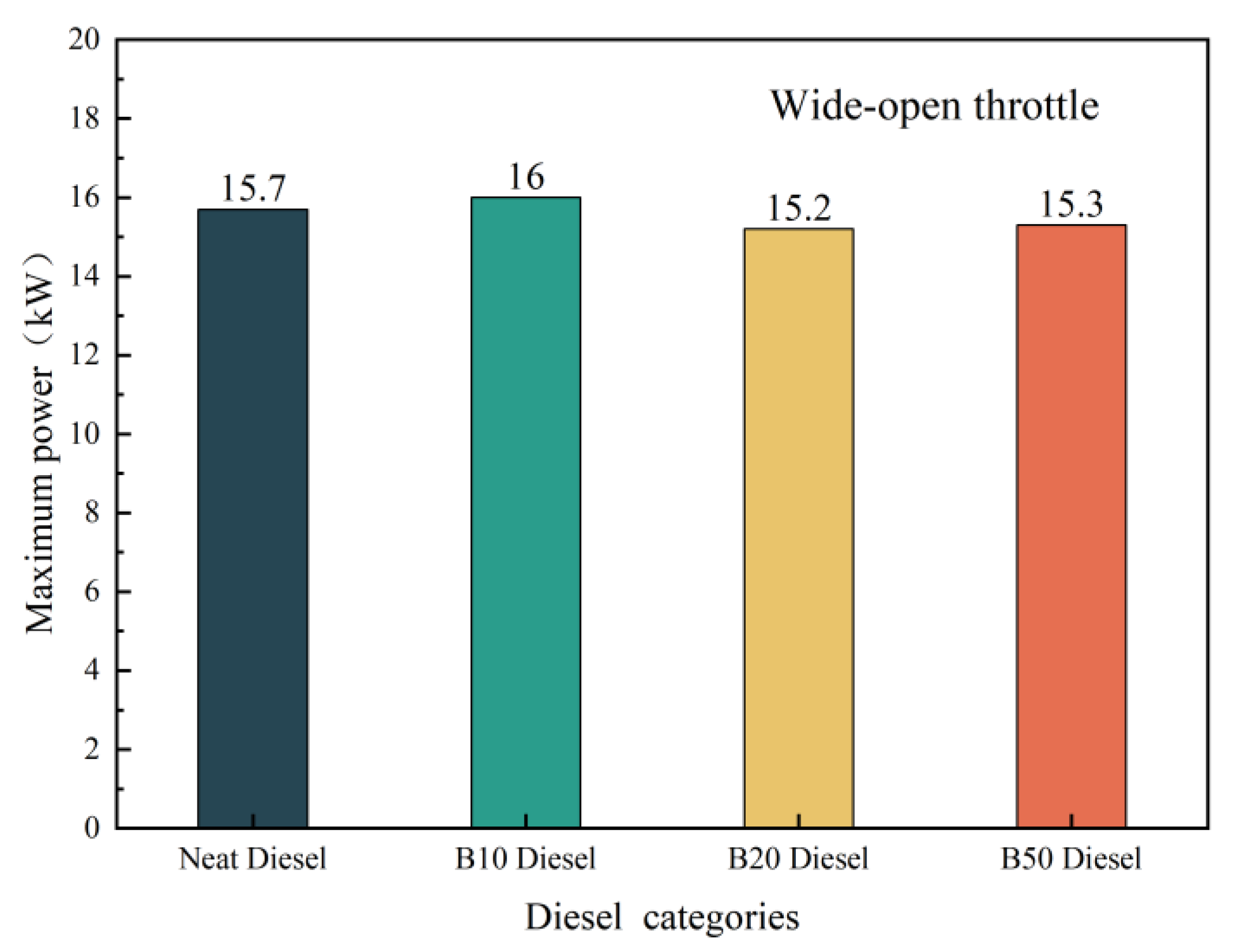
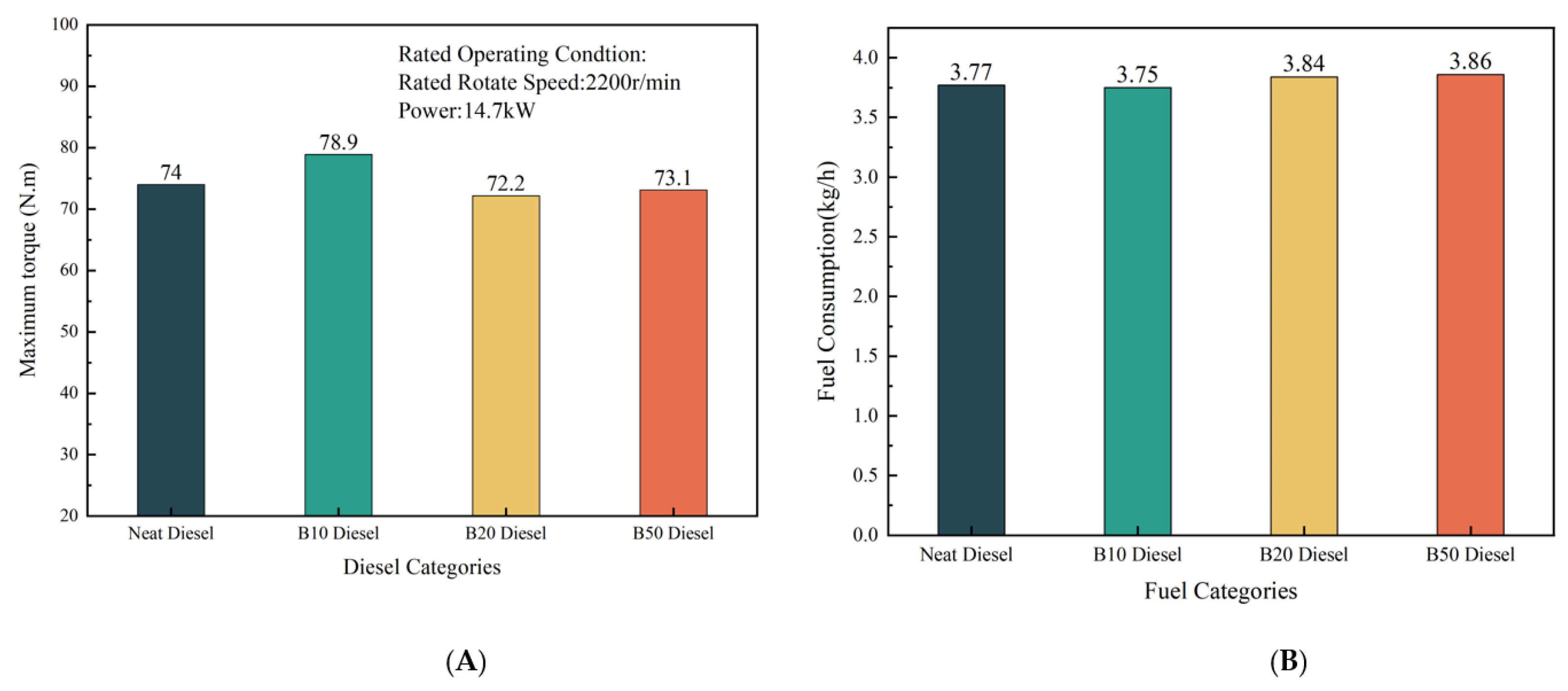
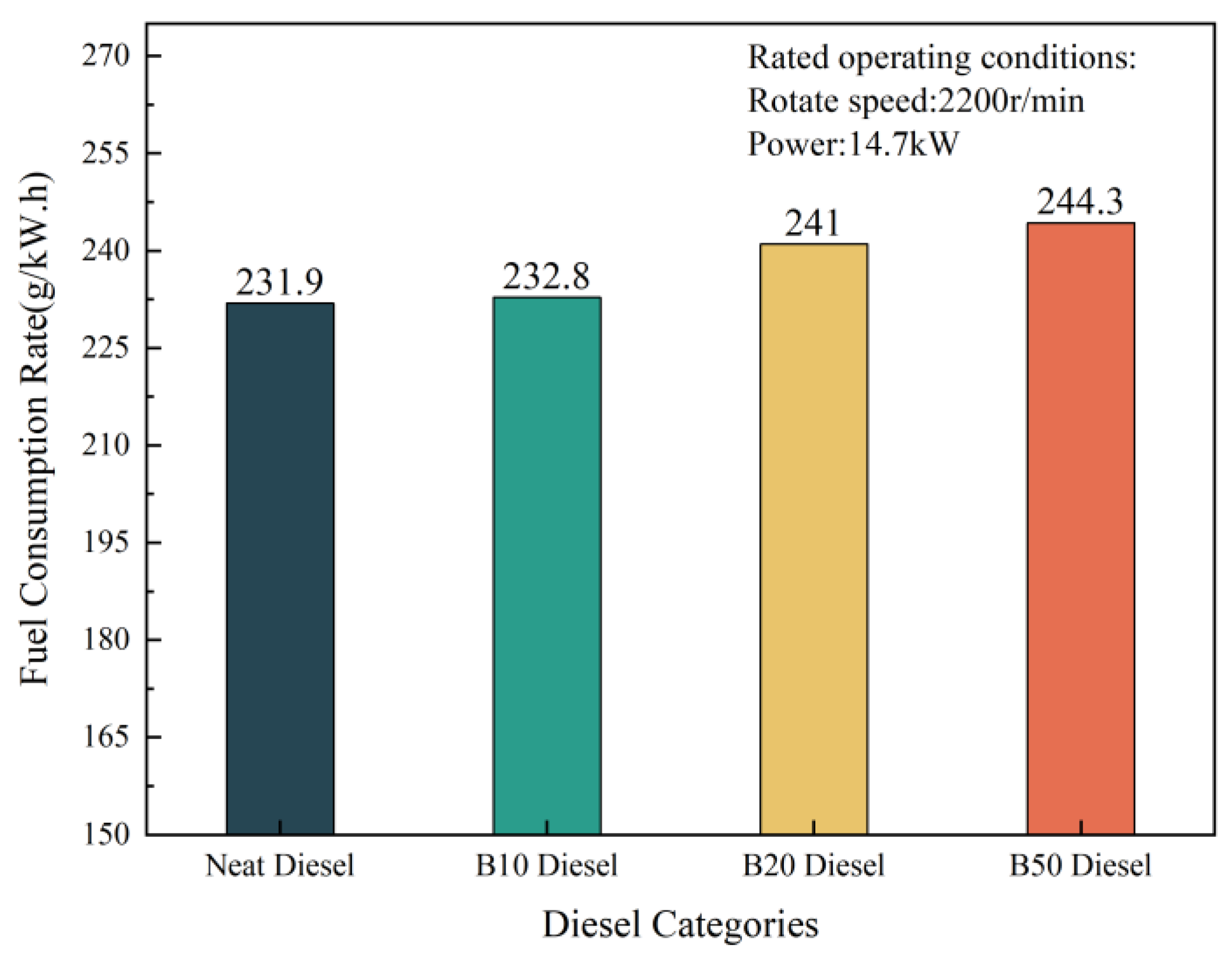
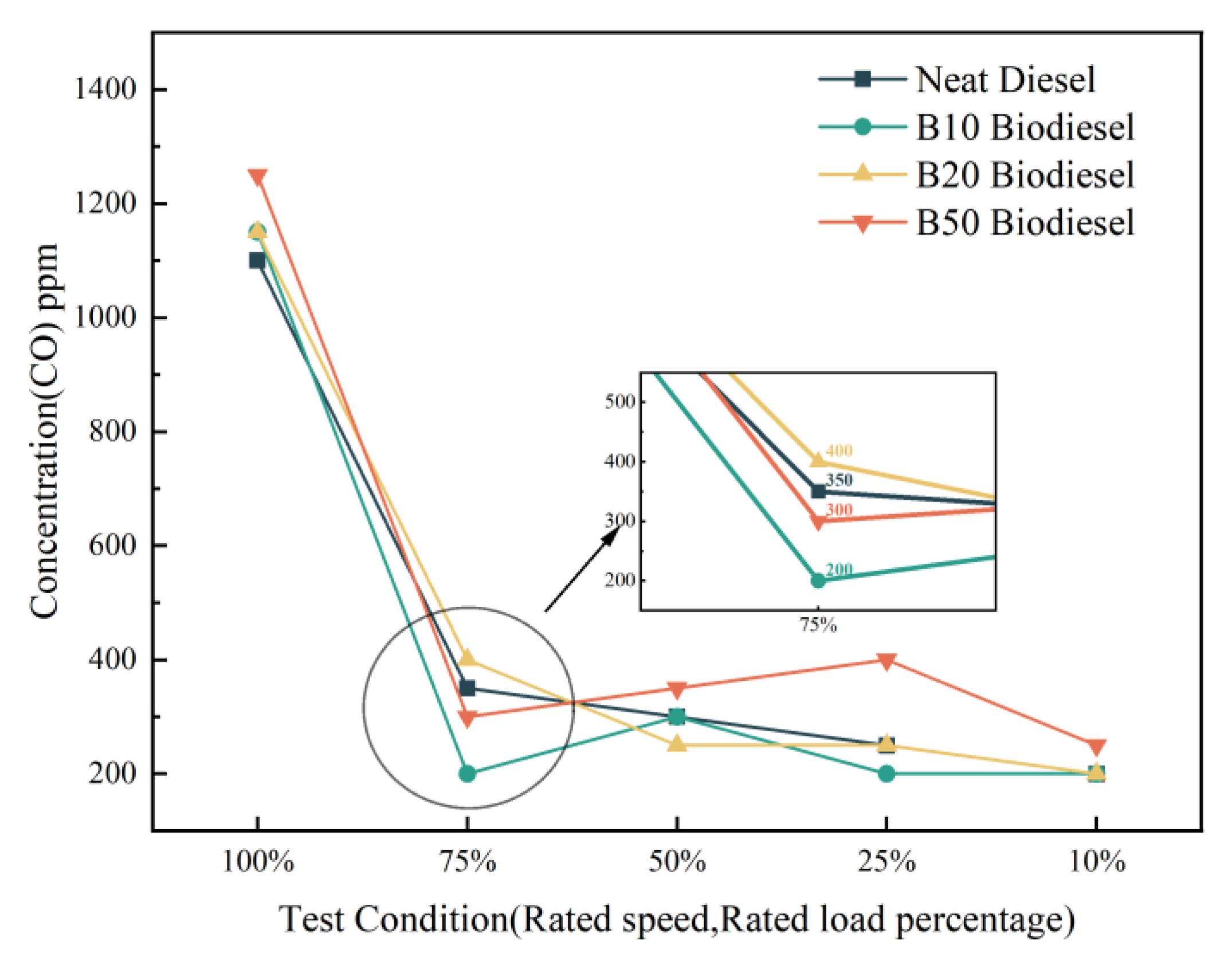
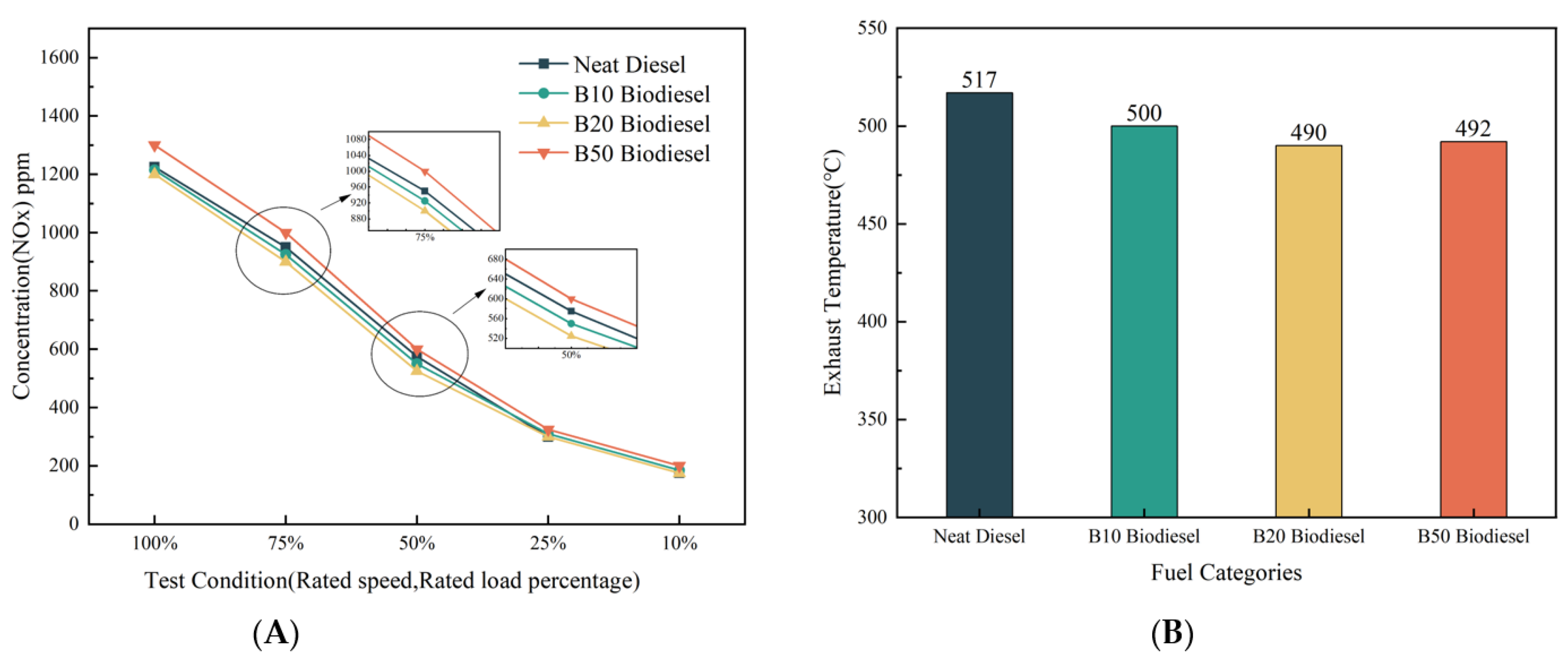



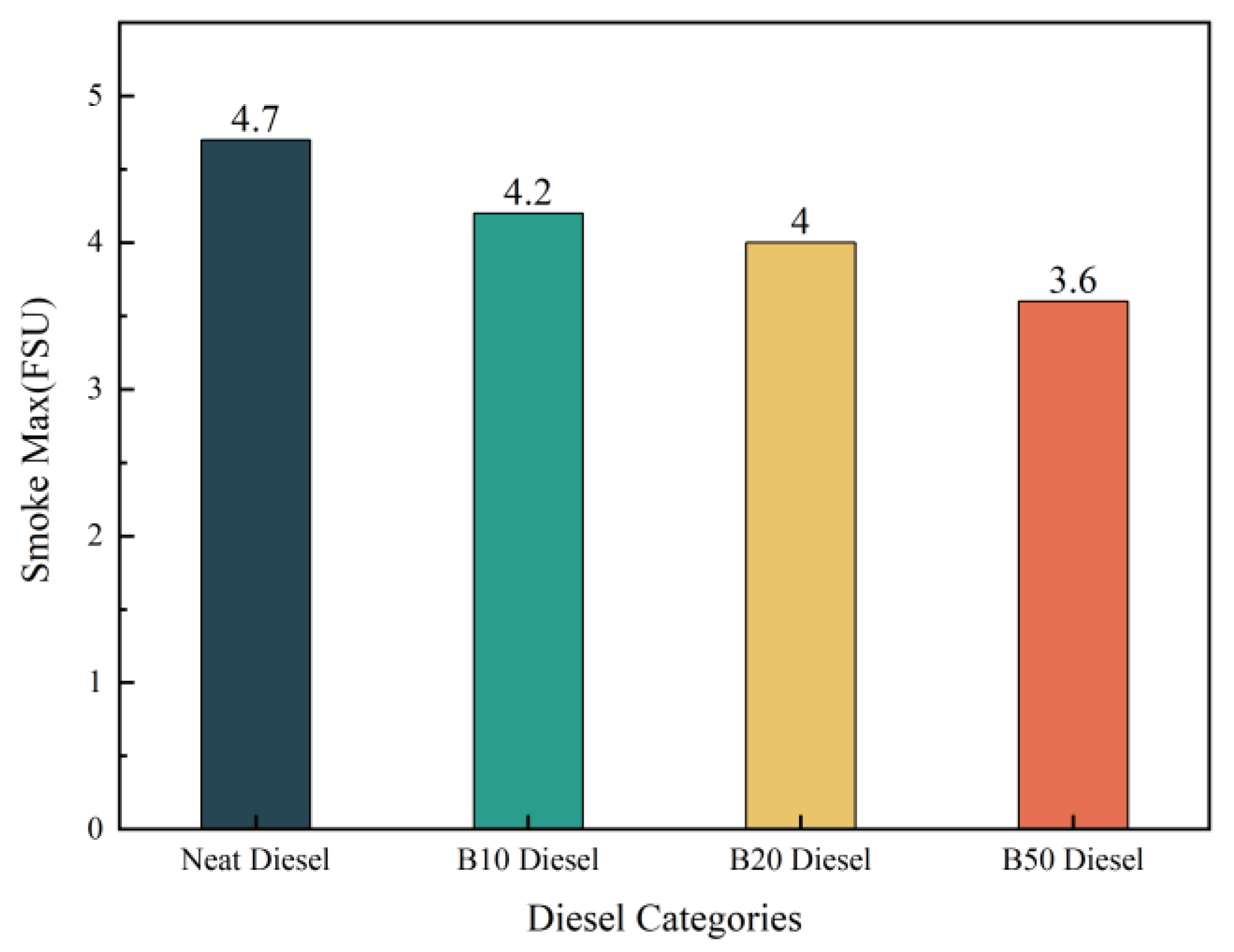
| Items | Target Requirement | Biodiesel | Neat Diesel | Detection Method a |
|---|---|---|---|---|
| Density (20 °C) kg·m−3 | 820–900 | 893 | 830 | GB/T2540 |
| Acidity/mg KOH·g−1 | ≤0.8 | 0.56 | ≤0.7 | GB/T264 |
| 10% Steam residue charcoal/% | ≤0.3 | 0.27 | ≤0.3 | GB/T17144 |
| Sulfated ash/% | ≤0.020 | 0.012 | — | GB/T2433 |
| Mechanical impurities | None | None | — | GB/T511 |
| Water content/% | ≤0.05 | 0.03 | — | SH/T0246 |
| Sulfur content/% | ≤0.05 | 0.003 | <0.2 | SH/T0689 |
| Copper corrosion (50 °C, 3 h) | ≤1 | 1 | 1 | GB/T5096 |
| Kinematic viscosity (40 °C)/mm2·s−1 | 1.9–6.0 | 5.02 | 4.7 | GB/T265 |
| Cold filter point/°C | ≤0 | −8.0 | ≤4 | SH/T0248 |
| Flashpoint/°C | ≥130 | 140 | ≥60 | GB/T261 |
| Cetane number | ≥49 | 56 | ≥49 | GB/T386 |
| 90 °C Recovered temperature/°C | ≤360 | 345 | ≤365 | GB/T6536 |
| Oxidation stability (110 °C)/h | ≥6.0 | 6.5 | — | EN14112 |
| Free glycerol content/% | ≤0.02 | 0.01 | — | ASTM D6584 |
| Total glycerol content/% | ≤0.24 | 0.12 | — | ASTM D6584 |
| Calorific value/kJ·kg−1 | — | 38,960 | 45,400 | — |
| Item | Content |
|---|---|
| Model | ZS1115GM |
| Number of Valves per Cylinder | 4 |
| Compression Ratio | 17:1 |
| Bore | 115 mm |
| Stroke | 115 mm |
| Engine Speed | 2200 rpm |
| Continuous output | 14.71 kW |
| Maximum output | 16.18 kW |
| Fuel consumption | ≤244.8 |
| Lubrication mode | Pressure and splash lubrication |
| Cooling method | Water-cooled evaporative |
| Starting mode | Electric starting |
| Appearance size (length × width × height) (mm) | 970 × 463 × 699 |
| Instruments | Type | Precision |
|---|---|---|
| Dynamometer | Xiangyi Electronic Dynamometer | Torque: ±0.2%F.S; Speed: ±5 rpm |
| Exhaust gas analyzer | AVL DiGas 4000 Light | CO: 0.01% vol HC: 1 ppm vol CO2: 0.02% vol O2: 0.01% vol NO: 1 ppm vol |
| Smoke meter | FBY-1 | ±2%F.S |
| Fuel consumption meter Oil temperature regulator Water temperature regulator | Xiangyi FC2210 Xiangyi FC2430T2 Xiangyi FC2422 | ±0.4% ±2 °C ±2 °C |
| Lambda meter | ETAS Lambda Meter | ±0.01 |
| Air flow meter | ToCeil-LFE100 | ±0.1% |
| Intake gas temperature sensor | PT100 | ±0.16 °C |
| Exhaust gas temperature sensor | K type thermocouple | ±0.18 °C |
| Item | B10 Biodiesel | B20 Biodiesel | B50 Biodiesel | Neat Diesel | ||||||||
|---|---|---|---|---|---|---|---|---|---|---|---|---|
| Exhaust Gas | NOX (10−6) | HC (10−6) | CO (10−6) | NOX (10−6) | HC (10−6) | CO (10−6) | NOX (10−6) | HC (10−6) | CO (10−6) | NOX (10−6) | HC (10−6) | CO (10−6) |
| 100% rated load | 1215 | 115 | 1150 | 1200 | 110 | 1150 | 1300 | 105 | 1250 | 1225 | 125 | 1100 |
| 75% rated load | 925 | 121 | 200 | 900 | 120 | 400 | 1000 | 130 | 300 | 950 | 155 | 350 |
| 50% rated load | 550 | 143 | 300 | 525 | 125 | 250 | 600 | 163 | 350 | 575 | 173 | 300 |
| 25% rated load | 310 | 141 | 200 | 300 | 120 | 250 | 325 | 155 | 400 | 300 | 168 | 250 |
| 10% rated load | 185 | 143 | 200 | 175 | 123 | 200 | 200 | 143 | 250 | 175 | 158 | 200 |
| Specific emission (g/kW·h) | 12.3 | 0.80 | 3.50 | 8.64 | 0.60 | 3.70 | 9.48 | 0.80 | 4.30 | 8.89 | 0.90 | 3.70 |
| Specific emission reduction (g/kW·h) | −3.41 | 0.10 | 0.20 | 0.25 | 0.30 | 0.00 | −0.59 | 0.10 | −0.60 | / | / | / |
| Specific emission reduction rate % | −38.3 | 11.1 | 5.41 | 2.8 | 33.3 | 0.0 | −6.6 | 11.1 | −16.2 | / | / | / |
| Ref. No | Biodiesel Feedstock | Power (N·m) | % Change in Power | BSFC (kg/kW·h) | % Change in BSFC | Engine Type |
|---|---|---|---|---|---|---|
| [52] | Soybean crude oil | 12.5 | 0.5% | 275 | 7.8% | Single cylinder, 4-stroke, DI diesel |
| [53] | Rapeseed oil methyl eater (ROME) | 13 | −0.5% | 375 | 21% | Turbocharged Diesel (DI) |
| [54] | Yellow grease with 9% free fatty acids | — | — | 234.29 | 14% | Direct injection (DI) diesel engine |
| [55] | Waste (frying) palm oil methyl ester | 50.78 | −2.5% | 241 | 7.5% | DI diesel engine |
| Tung oil-based | 15.2 | −3.2% | 273 | 4% | Single-cylinder, four-stroke diesel |
Disclaimer/Publisher’s Note: The statements, opinions and data contained in all publications are solely those of the individual author(s) and contributor(s) and not of MDPI and/or the editor(s). MDPI and/or the editor(s) disclaim responsibility for any injury to people or property resulting from any ideas, methods, instructions or products referred to in the content. |
© 2023 by the authors. Licensee MDPI, Basel, Switzerland. This article is an open access article distributed under the terms and conditions of the Creative Commons Attribution (CC BY) license (https://creativecommons.org/licenses/by/4.0/).
Share and Cite
Mu, Z.; Fu, J.; Zhou, F.; Yuan, K.; Yu, J.; Huang, D.; Cui, Z.; Duan, X.; Liu, J. A Comparatively Experimental Study on the Performance and Emission Characteristics of a Diesel Engine Fueled with Tung Oil-Based Biodiesel Blends (B10, B20, B50). Energies 2023, 16, 5577. https://doi.org/10.3390/en16145577
Mu Z, Fu J, Zhou F, Yuan K, Yu J, Huang D, Cui Z, Duan X, Liu J. A Comparatively Experimental Study on the Performance and Emission Characteristics of a Diesel Engine Fueled with Tung Oil-Based Biodiesel Blends (B10, B20, B50). Energies. 2023; 16(14):5577. https://doi.org/10.3390/en16145577
Chicago/Turabian StyleMu, Zhiyue, Jianqin Fu, Feng Zhou, Kainan Yuan, Juan Yu, Dan Huang, Zhuangping Cui, Xiongbo Duan, and Jingping Liu. 2023. "A Comparatively Experimental Study on the Performance and Emission Characteristics of a Diesel Engine Fueled with Tung Oil-Based Biodiesel Blends (B10, B20, B50)" Energies 16, no. 14: 5577. https://doi.org/10.3390/en16145577




